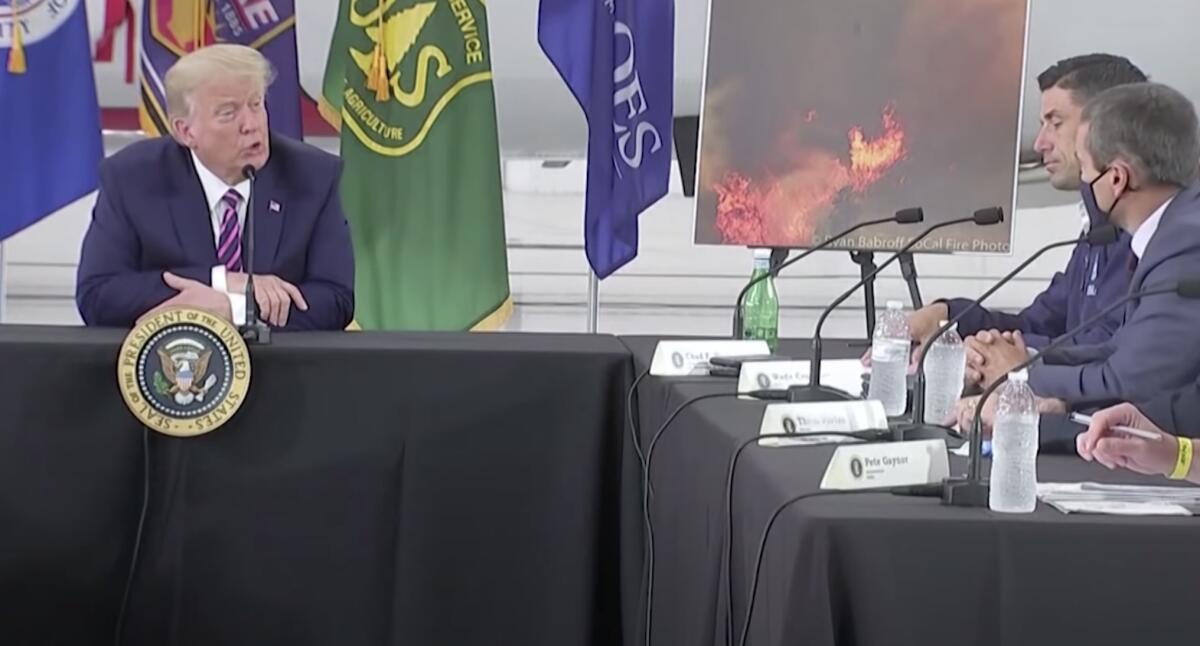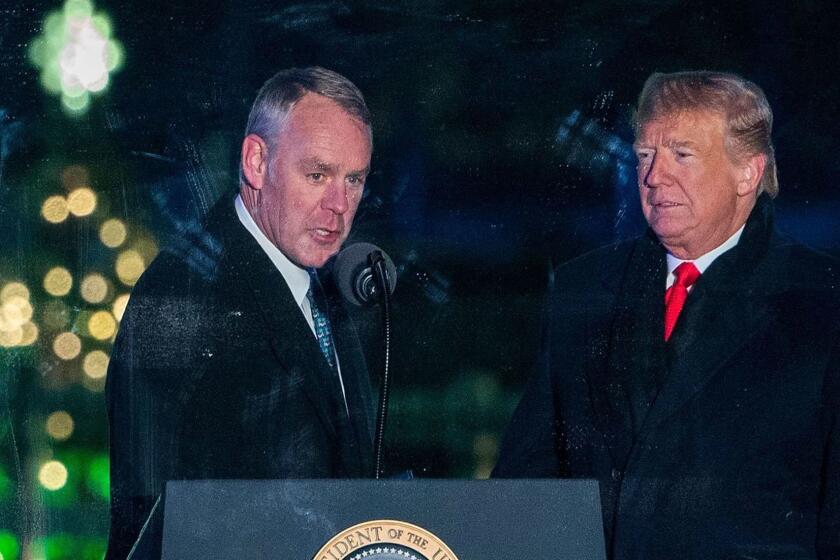Column: Conflict over wildfire causes isn’t about politics, but science vs. science denial

- Share via
In the weeks since the West began to fall under the grip of this summer’s wildfire holocaust, President Trump has been lambasted for not acknowledging the fires’ toll in his public statements, much less leaving Washington to view the damage for himself.
It was always hard to understand what would have been accomplished by a public statement or a personal visit. It’s even harder now, after Trump actually did come to California on Monday.
Showing his habitual imperviousness to the evidence of his own eyes or to the findings of scientific experts, Trump listened as a panel of state officials schooled him on the role of climate change in the devastation all about the Western U.S.
It’ll start getting cooler, you watch.
— President Trump, explaining away climate change
Then, wearing a cocksure grin, he dismissed their points.
Wade Crowfoot, the state’s natural resources secretary, told him “We’re seeing this warming trend making our summers warmer but also our winters warmer as well. ... We want to work with you to really recognize our changing climate and what it means to our forests.”
Trump replied, “It’ll start getting cooler. You just watch.”
“I wish science agreed with you,” Crawfoot said.
“I don’t think science knows, actually,” Trump said.
Of course, science does know.
The warming trend afflicting California and the West is indisputable, except to those with minds shut tight. That’s Trump in a nutshell.
This being an election season, the discrepancy on climate change policy between Trump and Democratic candidate Joe Biden has been shoehorned by reporters and pundits as political.
Just before Trump landed in Sacramento on Monday, Biden denounced him as a “climate arsonist” and described his own climate policies. The exchange is destined to land on the politics page, but it belongs on the science page because it’s a conflict between Biden’s acceptance of empirical science and Trump’s denial.
“All credible scientists are in complete agreement on the human cause of climate change,” says Patrick Gonzalez, a forest ecologist and climate change scientist at UC Berkeley. “Human-caused climate change has driven half the severity of a drought across the southwestern U.S., including California, from 2000 to today, the driest period since the 1500s.”
Trump’s answer to the intertwined climate and fire crises has been a succession of inch-deep talking points since he took office. His explanation of the region’s lengthening and increasingly destructive wildfire seasons has been wrapped up with his climate change denial, which dates back even further.
In 2012 he said “the concept of global warming was created by and for the Chinese in order to make U.S. manufacturing non-competitive.” That same year he tweeted, “In the 1920’s people were worried about global cooling--it never happened. Now it’s global warming. Give me a break!”
During a wintry cold snap in November 2018, he tweeted, “Brutal and Extended Cold Blast could shatter ALL RECORDS - Whatever happened to Global Warming?” Climatologists have long since learned to regard comments like these, mistaking the weather for climate, as the ravings of loons.
Trump’s prescriptions for wildfires are about as learned. During California’s then-record wildfire season in 2018 (likely destined to be surpassed this year), he blamed the fires on “bad environmental laws which aren’t allowing massive amount of readily available water to be properly utilized.” He complained that water needed for firefighting is being “diverted into the Pacific Ocean.”
This viewpoint was the product of claims by Central Valley growers that had nothing to do with the fires, but were aimed at grasping more irrigation water for themselves at the expense of other interests such as the environment and urban residents.
But the truth was that the diversion of water had zero impact on the state’s ability to fight wildfires.
No one would mistake President Trump for an expert on climate change or water policy, but a tweet he issued late Sunday about California’s wildfires deserves some sort of award for most glaring misstatements about those two issues in the smallest number of words.
Trump’s latest solution for the wildfires is something he describes as “forest management,” a term he continually repeats as if it’s a magic incantation. It’s unclear who put this phrase in his head, but in his mind it has something to do with clearing away dead brush and trees so they can’t become fuels for a conflagration after it’s sparked.
During an impromptu press conference on the tarmac before departing Sacramento airport, he said forest management is “something we can do something about quickly.”
Let’s unpack this suitcase full of misconceptions.
It’s true that “forest management” is an indispensable tool to alleviate the fire crisis, but it’s no panacea. As Crowfoot told Trump, “If we ignore [climate change] science and sort of put our head in the sand and think it’s all about vegetation management, we’re not going to succeed together protecting Californians.”
“When President Trump says it’s only forest management, that’s only one side of the story,” says Simon Wang, professor of climate dynamics at Utah State University.
Management may make forests more resistant to ignition triggers such as lightning, power lines or careless people, Wang told me, but “every time we have a trigger, that fire will get stronger because weather conditions under climate change make large fires more sustainable.”
It’s important to recognize that California’s ability to manage forests on its own is limited. That’s because 57% of the 33 million acres of forest land within the state is owned or managed by the federal government, and only 3% by the state.
Trump hasn’t lifted a finger to inspire better forest management by the U.S. Forest Service, National Park Service, or Bureau of Land Management, the key federal agencies with oversight of federal lands.
The state did reach a shared responsibility agreement with the Forest Service to manage federally owned forests — just one month ago, on Aug. 13.
Just two days after President Trump issued an utterly uninformed tweet about the causes of the California wildfires, his ulterior motives began to come into focus.
To place Trump’s claim that management can be “done quickly,” the agreement calls for federal help for California’s effort to reduce wildfire risks on 500,000 acres of woodland per year. The current outbreak of wildfires has burned 3.2 million acres this year already.
One factor complicating wildfire solutions in California and the West is baked into the problem, so to speak, by historical practice. That’s the expansion of the so-called wildland-urban interface — put simply, the encroachment of residential development into the forests.
State and local governments did little or nothing to control that expansion or demand that homes in the interface be hardened against fire through fireproof construction and buffers of fire-resistant vegetation. Nor did the federal government.
The trend led to changes in government fire suppression policies. As the state Legislative Analysts Office reported in 2018, through most of the 19th Century, federal policy was to allow naturally-ignited fires to burn themselves out.
By 1935, however, development in forest lands prompted a change toward suppression — federal policy was to suppress wildfires by 10 a.m. the morning after they were spotted. The state assumed the responsibility to suppress fires on state-managed lands around the same time.
In the 1960s, however, federal and state policies diverged. The federal government moved back to allowing wildfires to burn as natural ecological events, unless they directly threaten developed properties. The state has maintained its goal of suppressing natural wildfires, largely because there’s more development encroaching on state-managed lands.
Among the up-is-down, night-is-day practices of the Trump administration, one of the most dangerous and disturbing is its habit of turning America’s leading science agencies into hives of anti-science policymaking.
“Outdated policies of suppressing all fires, even natural ones, have caused unnatural accumulations of woody fuel in western U.S. forests,” Gonzalez says. “At the same time, human-caused climate change has intensified the heat that drives wildfires and has doubled burned area over natural levels across the western U.S. since 1984. The combination of old fuel accumulation and human-caused climate change increased burned area 900% since 1984.”
The outbreaks of major fires in recent years have forced the state to spend exponentially more on fire suppression than proactive forest management — firefighting expenses of the state Dept. of Forestry and Fire Protection, or Cal Fire, rose to $2.3 billion in 2017-18 from $650 million in 1998-99 (adjusted for inflation), according to the Legislative Analysts.
Meanwhile, the budget for resource management and prevention remained at an average of about $77 million a year.
That points to another issue Trump doesn’t address when he urges “forest management” as the be-all and end-all of wildfire policy — who will pay?
The U.S. Forest Service has increasingly diverted its budgeted funds to firefighting, a procedure known as “wildfire borrowing.” But the Trump White House has been trying to cut the service’s budget across the board, leaving less for firefighting, for forest management, and for state and local assistance.
As he does habitually in the face of crisis, Trump has given up on the hard work of policymaking in favor of the indolence of magical thinking. His assurance that things will get “cooler” and thereby stem the fire catastrophe only echoes his public assurances that the coronavirus would disappear in a snap — in that case it was hot weather that would supposedly eradicate the threat.
This approach never leads to any solution. It’s merely a way to dodge responsibility through denial. It hasn’t provided an answer to the toll of COVID-19 deaths in the U.S., which now exceed 190,000. It won’t provide an answer to the crisis of climate change, the signs of which could be seen by Trump through the windows of Air Force One, if he bothered to look.
More to Read
Inside the business of entertainment
The Wide Shot brings you news, analysis and insights on everything from streaming wars to production — and what it all means for the future.
You may occasionally receive promotional content from the Los Angeles Times.












